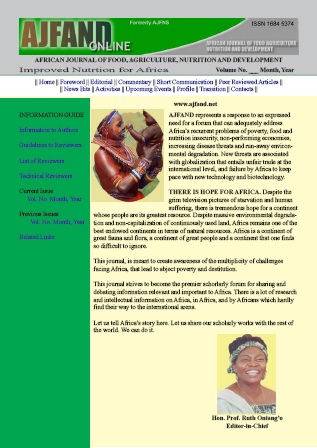
|
African Journal of Food, Agriculture, Nutrition and Development
Rural Outreach Program
ISSN: 1684-5358
EISSN: 1684-5358
Vol. 14, No. 2, 2014, pp. 8725-8735
|
 Bioline Code: nd14021
Bioline Code: nd14021
Full paper language: English
Document type: Research Article
Document available free of charge
|
|
|
African Journal of Food, Agriculture, Nutrition and Development, Vol. 14, No. 2, 2014, pp. 8725-8735
| en |
DESCRIPTIVE AND CONSUMER PREFERENCE OF Omashikwa, TRADITIONAL FERMENTED BUTTERMILK FROM NAMIBIA
Bille, P.G.
Abstract
Omashikwa, traditional fermented buttermilk processed by the Owambo and Herero communities from the North and Central Namibia has become very popular among the local consumers. However, its sensory quality fluctuates from one household to the next due to poor hygiene, sanitation and the non-standardized traditional processing technologies. The raw milk from indigenous cows is fermented traditionally in calabashes without the addition of known starter cultures. Milk in the calabash is then stored in a warm place in the house for two to three days to ferment. Once it is fermented, it is shaken or agitated in the calabash for hours to churn into butter. Butter granules are removed and either made into butter or boiled to make Ghee or butter oil known as Omazeothung’ombe by the Herero community and the remaining liquid is the fermented buttermilk or Omashikwa, Consumers of Omashikwa have been complaining about its sensory quality fluctuations. The Department of Food Science and Technology of the University of Namibia took the initiative of finding out its problems by subjecting it to sensory evaluation in order to improve its quality. The sensory properties of two samples of fermented buttermilk (Omashikwa); the traditional and laboratory processed Omashikwa were investigated by descriptive and consumer preference analyses for improvement. Eight trained panelists using a 5-point hedonic scale were used to investigate the descriptive sensory characteristics of Omashikwa, while 45 consumers familiar with Omashikwa, determined the preference product of their choice. The results for traditional Omashikwa (TO) were compared to the laboratory made Omashikwa (LO). The descriptive attributes scores on the levels of syneresis 3.4 (2.9), filth 3.0 (1.8), rancidity 3.4 (1.8) and bitterness 4.2 (2.5), and were significantly higher for traditional omashikwa than LO. Aroma 2.6 (4.2), viscosity 2.5 (3.8) and texture 2.7 (4.2) were lower in traditional Omashikwa and this may explain the 80% consumer preference compared to the laboratory made Omashikwa. The application of good manufacturing practices (GMPs) on unit operations, particularly filtration and heat treatment of milk prior to fermentation and Hazard Analysis Critical Control Point (HACCP) contributed significantly to the improvement and perceived sensory characteristic differences that exist between the traditional and laboratory made Omashikwa.
Keywords
Descriptive; Preference; fermentation; buttermilk; Omashukwa
|
| |
© Copyright 2014 - African Journal of Food, Agriculture, Nutrition and Development
Alternative site location: http://www.ajfand.net/
|
|
